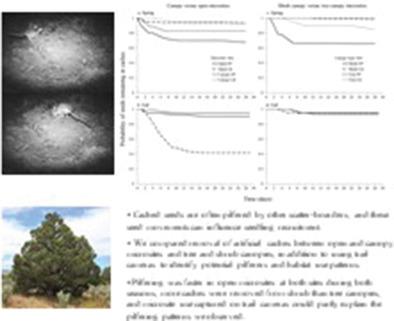当前位置:
X-MOL 学术
›
Integr. Zool.
›
论文详情
Our official English website, www.x-mol.net, welcomes your
feedback! (Note: you will need to create a separate account there.)
Pilfering of western juniper seed caches by scatter-hoarding rodents varies by microsite and canopy type
Integrative Zoology ( IF 3.5 ) Pub Date : 2021-01-12 , DOI: 10.1111/1749-4877.12517 Lindsay A Dimitri 1 , William S Longland 1
Integrative Zoology ( IF 3.5 ) Pub Date : 2021-01-12 , DOI: 10.1111/1749-4877.12517 Lindsay A Dimitri 1 , William S Longland 1
Affiliation

|
Scatter-hoarding rodents store seeds throughout their home ranges in superficially buried caches which, unlike seeds larder-hoarded in burrows, are difficult to defend. Cached seeds are often pilfered by other scatter-hoarders and either re-cached, eaten or larder-hoarded. Such seed movements can influence seedling recruitment, because only seeds remaining in caches are likely to germinate. Although the importance of scatter-hoarding rodents in the dispersal of western juniper seeds has recently been revealed, the level of pilfering that occurs after initial burial is unknown. Seed traits, soil moisture, and substrate can influence pilfering processes, but less is known about how pilfering varies among caches placed in open versus canopy microsites, or how cache discovery and removal varies among different canopy-types, tree versus shrub. We compared the removal of artificial caches between open and canopy microsites and between tree and shrub canopies at two sites in northeastern California during late spring and fall. We also used trail cameras at one site to monitor artificial cache removal, identify potential pilferers, and illuminate microsite use by scatter-hoarders. Removal of artificial caches was faster in open microsites at both sites during both seasons, and more caches were removed from shrub than tree canopies. California kangaroo rats were the species observed most on cameras, foraging most often in open microsites, which could explain the observed pilfering patterns. This is the first study to document pilfering of western juniper seeds, providing further evidence of the importance of scatter-hoarding rodent foraging behavior in understanding seedling recruitment processes in juniper woodlands.
中文翻译:

分散囤积的啮齿动物盗窃西部杜松种子藏匿处因微型站点和树冠类型而异
分散囤积的啮齿动物将种子储存在其整个家园范围内的浅埋藏匿处,这些藏匿处与储存在洞穴中的种子不同,难以防御。缓存的种子经常被其他散布囤积者偷走,然后重新缓存、食用或囤积。这样的种子移动会影响幼苗的补充,因为只有留在缓存中的种子才有可能发芽。尽管最近揭示了分散囤积啮齿动物在传播西部杜松种子中的重要性,但在最初埋葬后发生的盗窃水平尚不清楚。种子性状、土壤湿度和底物会影响盗窃过程,但对于放置在开放式微型站点与冠层微型站点中的藏匿处之间的盗窃如何变化,或者不同冠层类型(树木与灌木)之间的藏匿处发现和清除如何变化,我们知之甚少。我们比较了春末和秋季期间加利福尼亚州东北部两个地点的开放和树冠微型站点之间以及树木和灌木树冠之间的人工缓存的去除情况。我们还在一个站点使用跟踪摄像机来监控人工缓存清除,识别潜在的盗窃者,并阐明分散囤积者对微型站点的使用。在两个季节,两个站点的开放微型站点中人工缓存的清除速度更快,并且从灌木中清除的缓存比树冠中的更多。加州袋鼠是在摄像机上观察到最多的物种,最常在开放的微型场所觅食,这可以解释观察到的偷窃模式。这是第一项记录盗窃西部杜松种子的研究,
更新日期:2021-01-12
中文翻译:

分散囤积的啮齿动物盗窃西部杜松种子藏匿处因微型站点和树冠类型而异
分散囤积的啮齿动物将种子储存在其整个家园范围内的浅埋藏匿处,这些藏匿处与储存在洞穴中的种子不同,难以防御。缓存的种子经常被其他散布囤积者偷走,然后重新缓存、食用或囤积。这样的种子移动会影响幼苗的补充,因为只有留在缓存中的种子才有可能发芽。尽管最近揭示了分散囤积啮齿动物在传播西部杜松种子中的重要性,但在最初埋葬后发生的盗窃水平尚不清楚。种子性状、土壤湿度和底物会影响盗窃过程,但对于放置在开放式微型站点与冠层微型站点中的藏匿处之间的盗窃如何变化,或者不同冠层类型(树木与灌木)之间的藏匿处发现和清除如何变化,我们知之甚少。我们比较了春末和秋季期间加利福尼亚州东北部两个地点的开放和树冠微型站点之间以及树木和灌木树冠之间的人工缓存的去除情况。我们还在一个站点使用跟踪摄像机来监控人工缓存清除,识别潜在的盗窃者,并阐明分散囤积者对微型站点的使用。在两个季节,两个站点的开放微型站点中人工缓存的清除速度更快,并且从灌木中清除的缓存比树冠中的更多。加州袋鼠是在摄像机上观察到最多的物种,最常在开放的微型场所觅食,这可以解释观察到的偷窃模式。这是第一项记录盗窃西部杜松种子的研究,









































 京公网安备 11010802027423号
京公网安备 11010802027423号